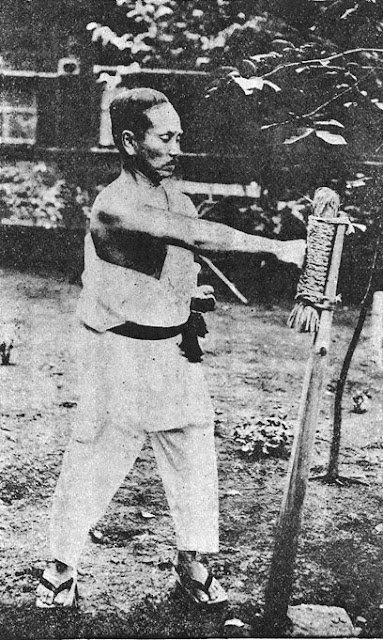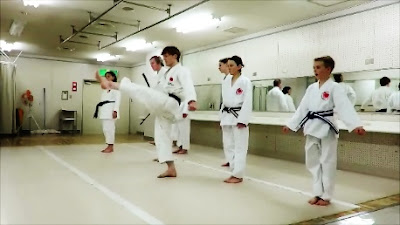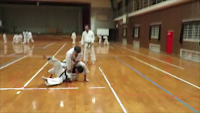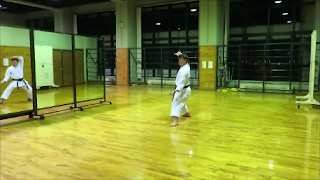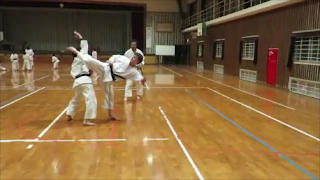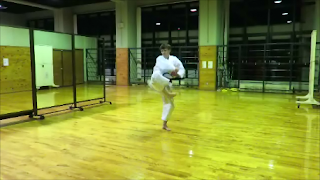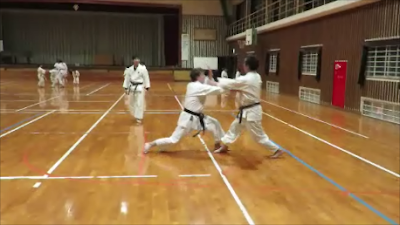![]()
Introduction - Kihon, Kata and Kumite are one: I was given a request to write some notes on choku-zuki. I hope that readers will find these useful. Before I begin, I'd like to emphasize two utterly critical points. Firstly and fore-mostly, kihonwaza (the fundamental techniques)—and, indeed, kata, yakusoku kumite, etcetera—never stand alone. They must also be practiced in a freestyle context; that is, in jiyu-kumite (dojo kumite, traditional shobu ippon or otherwise).If they do not relate to an free actual engagement, they are nothing more than movements. Secondly, and inseparable from the first point: "always extend the practice of all attacking techniques 'being worked' into `uchikomi training' and/or hitting the makiwara/sandbag". Put another way, hone your tsukiwaza into effective weapons ("...by working them the way you actually /will use them"). To provide an analogy, think of a pro-baseball player like Japan's Suzuki Ichichiro... Of course, Ichichiro doesn't just `solo practice' swinging his bat. He also has to practice his swing against high level pitchers, so it will be effective in actual games. Yes, fundamental training such as solo work is essential, but training cannot stop there. How and what you practice is what you will become. So many instructors and dojo (clubs) fail to directly link kihon, kata, kumite and kata application to freestyle. Kihon for kihon's sake, kata for kata's sake, application losing kihon and kata, kumite just to win competitions... These are all wrong if one is seeking authentic Budo karate. My point here is: never loose sight of the fact that 'the training of techniques' (irrespective of what they are) must lead to a pragmatic outcome; that is, 'to how the technique will actually be applied'. Yes, the three K's are one and, thus, choku-zuki is a significant piece within this puzzle: as it underpins all of the linear punches of Shotokan-Ryu (and arguably, the circular punches as well)…
Choku-zuki tuition and adaptability: On to the 14 key points that I PRESENTLY EMPHASIZE in the instruction of choku-zuki. I say 'presently emphasize' as these points naturally evolve/adapt depending on my own karate training objectives/needs; increased learning from my seniors here in Japan, my colleagues, and my own daily practice; the needs of those whom I coach; and so on. Also, these points naturally vary in degrees of emphasis based on people's innate and learned differences: both correct and incorrect. Irrespective of such a seemingly ambiguous remark, I believe that these notes can immensely improve one's physical understanding, training, and application of choku-zuki; and consequently, this will improve other tsukiwaza, and Karate-Do in general.
14 POINTS TO IMPROVE CHOKU-ZUKI1. Shisei (posture) correct: alignment of the pelvis/hips, backbone and neck/head position. For me, this is the start point of all techniques as it determines everything else. Once you have a 'set shisei' based on a precise shomen/zenmi in hachiji-dachi you have the canvas for a good choku-zuki and Karate-Do in general. This sounds simple, and it is, but when movements, centre of gravity, positions, and environmental aspects change: it can be challenging. Never forget, posture influences balance, breathing, emotions, self-confidence and spinal health.
2. Eyes fixed and zanshin diligently maintained: Imagine at triangle formed by the shoulders and eyes. You must be able to see all four limbs of an opponent and have maximum peripheral awareness for other opponents/harmful stimuli. Practice this, even without an opponent in front of you. In this regard, try to empty your mind and to fully be in the moment; that is, be 'open' to your environment as opposed to being closed and, therefore, `restricted within yourself'. Needless to say, this is not only visual, but relates to your other senses and constitutes zanshin. I make no apologies if I sound a little ‘Zen’ here. I'm certainly not a Buddhist but a clear mind in fighting is
very difficult to achieve, due to fear and adrenaline; nonetheless, this should be the ultimate aim of every martial artist. I'll add here that while I've had moments of mushin in kumite (and in real fights, whilst in the security industry), I’m far from consistent in this regard. Moreover, I sincerely believe that this is at the helm of martial arts mastery: literally beyond technique.
3. Hiki-te parallel with the floor(this is one is a present weakness I have), shime applied to the wakibara (arm pits) and hiji (elbows): The `feeling' is tension from the skeletal system as opposed to the muscles much like `pulling back the string of a bow'. The hiki-te and the firing out of the punching arm, when practicing choku-zuki, is the first and most obvious example of tai no shinshuku (the contraction and expansion/stretching of the body) for beginner karateka.
4
. Seiken of hiki-te and punching hand correctly formed and twisted (hikite - small finger side higher; tsuki - small finger side slightly lower): Note: Please use this, and points 1-3, as a reference for all Karate-Do techniques).
5. Trajectory of the tsuki is straight from the 'hiki-te position' to the chushin (edge of seiken on the chushin upon completion): Note, this is merely a reference for targeting practice. Of course, in application it always 'case-by-case'; accordingly, this elucidates the discipline of fundamental training, which makes the freestyle forms of techniques much easier to perform - if techniques are trained correctly and with enough repetitions.
6. The forearm of the punching arm/wrist is turned over at the end of the tsuki: Apply shime to the punching with the feeling of ura-zuki across the path (a good point of reference is the punch going from ura-zuki to tate-zuki and finally seiken-zuki with the elbow brushing the side of the body as opposed to flaring out). Many instructors more-so focus on the tate-zuki in this action; however, I personally recommend ura-zuki if one finds their twisting of the wrist forearm troublesome. This is because the maintaining of ura-zuki, with subtle shime, will still eventuate in a three range transition, but is easier to control at high speed: which will obviously still encompass tate-zuki/tate-ken when `corkscrewing' into seiken (but at an imperceptibly slightly later movement in one's punching action).
7. In the case of the hiki-te, do not hit/slap the body but, rather, bring it straight back to the side: Try to `out-speed' your punch with your hiki-te whilst, at the same time, still harmoniously working together. Note - slapping the body with the hiki-te may create at false sound of power, which may impress amateurs and sports karate lovers, but it will also reduce your speed and power (by not traveling on the b-line). In other words cheating to look (sound???) stronger literally results in cheating and undermining one's karate prowess.
![]() |
| Funakoshi Gichin Sensei practicing an `angular choku-zuki' on the makiwara. |
8. The hips remain in shomen by one of two methods: (a) the simple form: the hips remain `sono mama' (unchanged/where they are); or
(b) by hip vibration: slightly going towards the punch then reversing back into shomen. Put another way, this `koshi no kaiten' is the combination of jun-kaiten (regular rotation: hips going in the same direction of the technique) followed immediately by gyaku-kaiten (reverse rotation: the hips moving in the opposite direction/inverting into the technique). What is ironic is that the first method, where the hips remain motionless, is actually far more difficult.
9. The shoulders remain either: (a) perfectly square (the simple form); or
(b) snapped; that is the front of the torso and hips remain square, however, the back muscles are engaged: via the stretch/extension of the deltoids. Point of note: some instructors disallow the use of `shoulder snap' in the `core' kihon, kata and yakusoku-kumite. I completely respect this approach and understand the logic underpinning it; however, I personally advocate extending the deltoids to engage latissimus-dorsi. In my case, I am physically not strong and my reach is short... Accordingly, to not gain some extra power—from my lats—and a bit more reach, in my case, would unequivocally be nonsensical.
10. Power is generated from the ground, up through the legs, and from the centre of the body: This point highlights the adage of ichigekki-hissatsu (to `finish off' in a single action': drawing every millimeter of power to deliver an optimal blow). Paradoxically, to achieve maximum power from the ground, and then to utilize the body optimally, techniques are delivered with junansei (softness), smoothness and natural energy: as opposed to being `forced' or 'brute strength'. Yes, brute strength works well in real fights if you are big and strong (and aggressive), but if the big, strong and aggressive person keeps in a state of relaxation, they will be far more dangerous. Try to think of lightness and speed to snap (or whip out) your techniques. In this way, you will only use the muscles you need and avoid curtailing your transfer of power. I tell my students to imagine their muscles hanging off their bones and joints, thereby, helping them to eradicate muscular tension. The 'way power is generated' is without a doubt 'THE major difference between Japanese karateka and the majority of their non-Japanese counterparts'. Don't get confused about `kime' and lock up the muscles, instead,
think of kime as being:
(a) `where you decide to complete your punch or technique': decide the target and,
(b) in the case of kumite, also the depth of your target penetration. Let the body do everything naturally. Compare a choku-zuki where you are relaxed and one where you consciously tense all your muscles for a split second. Likewise, get on the sand bag and test your tsukiwaza. You want to dent the bag not push it. Please don't mindlessly believe what I say or write, test it yourself!!! Finally, just to relate kime to `generating power from the ground', just remember that "...kime is a decision to use your entire body to achieve maximum output": it is to conjure up every source of energy possibly to decisively impact on the opponent. This, as Nakayama Masatoshi Sensei pointed out, is a unique characteristic of the techniques of Karate-Do. Furthermore, this is why Karate-Do capacity is not totally dependent on the advantages of size and strength.
11. Remember to breath naturally: Unnaturally holding one's breath is never good. In saying that, the percentage of breath held/reserved and exhaled can be varied for maximum effect. Avoid audible breathing without purpose. This is not only Hollywood karate, but also exposing your breathing pattern to your opponent(s). With the exception of the kiai, breathing should be full, yet (in the case of Shotokan) stealthy. Learn to attack on your opponents inhalation and to harmonize your breathing with their's. This skill is one possessed by all senior karateka irrespective of audibility.
12. Targeting, basic points in regards to tachikata (stance) and other bodily weapons: In the case of choku-zuki, the typical targets are the jinchu (the area just below the nose/upper lip), the suigetsu (solar-plexus), and the myojo (basically the lower abdomen just above the groin). Furthermore, the stance in basic training tends to be shizentai/hachiji-dachi and kiba-dachi. Practicing a straight punch from the natural position/hachiji-dachi, on the spot, is unambiguously a very important exercise for actual self-defence (that is, punching immediately on the spot). Choku-zuki in kiba-dachi is superb method for finding your chushin and checking how efficient your body balance is: in regards, to uniformity and dividing the torso in half. Beyond seiken as the base practice of choku-zuki, other karada no buki (weapons of the body) must be practiced i.e. - nakadaka ippon-ken, teisho, shihon-nukite etcetera. That being said, seiken is the main practice as it is the base of hand strength. This is something I came to profoundly appreciate thanks to Nakamura Masamitsu Shihan in Kumamoto (Shototakuhirokan), where I trained for two years.
13. Choku-zuki body action can also be improved with various forms of unsoku (leg movements): for example, yori-ashi, 90 degree turns, 180 degree turns, 360 degree turns, jumping, and so forth. Likewise it can directed towards different targets/directions i.e. - 45 degree, 90 degrees etc. Such training allows one to “…further develop the fundamental principles of choku-zuki, via various body shifts”; thereby, stimulating accelerated technical progression. In this regard, also consider the choku-zuki found in Bassai-Dai, Kanku-Dai, Gojushiho-Sho and other kata, which all DIRECT RELATE to oyo (practical application).
14. For high level Karate-Do practitioners, the body is divided into many sections, which can be used together, separately and various orders: For example, the front of the torso alone is divided into six specific parts. This point elucidates VERY HIGH LEVEL Karate-Do and requires extreme mastery of the fundamentals: resulting in special execution of techniques and jiyu-kumite application. Taken as a whole, whilst choku-zuki is widely classified as 'simple technique', it can be used to train advanced Karate. Indeed, this is a generic rule that pertains to all of the core fundamental techniques.
Brief Conclusion: In all of this, there is a danger which can cancel out the very purpose of Karate technique, which was stressed at the start of this article. This purpose is that "...Karate as budo, is a martial art of actual effectiveness, as opposed to being merely `art for arts sake'" (as I often state in my articles). This danger can be elicited by two common means. The first danger, as stated above, is by 'not directly connecting techniques and drills to freestyle application'. The second danger, is when one gets 'so bogged down in technical details' that they also get swept away from technical pragmatism.
Solutions:The means for countering these issues are actually rather simple: (1) by prioritizing and actively seeking effectiveness at all times (what I refer to as `Budo Intention');
(2) regularly completing high repetitions of the core fundamentals such as choku-zuki (thereby, honing `consistent' excellence); and
(3) constantly engaging in competitive `dojo jiyu-kumite'. In this way, the key points of any given technique become second nature for the body: as opposed to being nothing more than theoretical notions and flash drills, which can't be used in real world self-defence.
Again, I hope you have found this article useful and that it once more reflects how—in traditional Japanese Budo Karate—kihon, kata and kumite are literally one. Kindest regards from Oita, Japan. – André.
© André Bertel. Oita City, Japan (2015).


